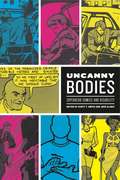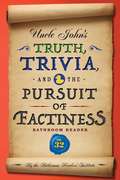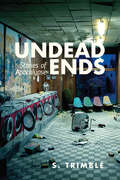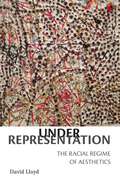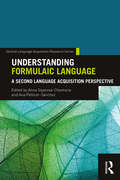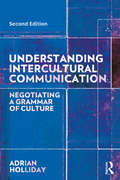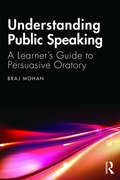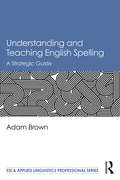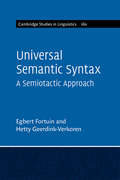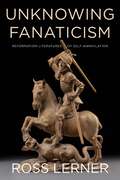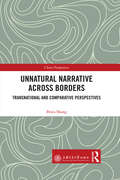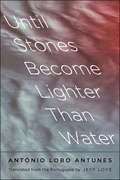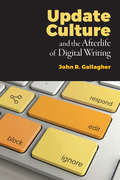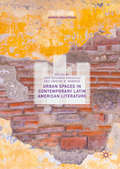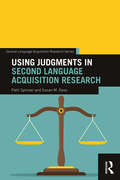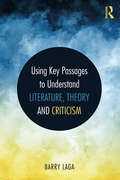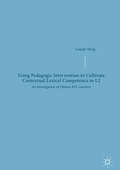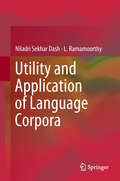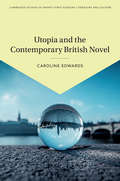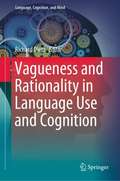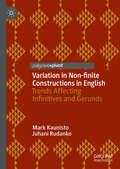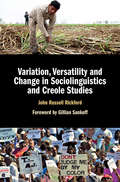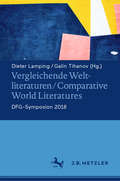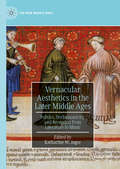- Table View
- List View
Uncanny Bodies: Superhero Comics and Disability (Graphic Medicine)
by Scott T. Smith José AlanizSuperhero comics reckon with issues of corporeal control. And while they commonly deal in characters of exceptional or superhuman ability, they have also shown an increasing attention and sensitivity to diverse forms of disability, both physical and cognitive. The essays in this collection reveal how the superhero genre, in fusing fantasy with realism, provides a visual forum for engaging with issues of disability and intersectional identity (race, ethnicity, class, gender, and sexuality) and helps to imagine different ways of being in the world.Working from the premise that the theoretical mode of the uncanny, with its interest in what is simultaneously known and unknown, ordinary and extraordinary, opens new ways to think about categories and markers of identity, Uncanny Bodies explores how continuums of ability in superhero comics can reflect, resist, or reevaluate broader cultural conceptions about disability. The chapters focus on lesser-known characters—such as Echo, Omega the Unknown, and the Silver Scorpion—as well as the famous Barbara Gordon and the protagonist of the acclaimed series Hawkeye, whose superheroic uncanniness provides a counterpoint to constructs of normalcy. Several essays explore how superhero comics can provide a vocabulary and discourse for conceptualizing disability more broadly. Thoughtful and challenging, this eye-opening examination of superhero comics breaks new ground in disability studies and scholarship in popular culture.In addition to the editors, the contributors are Sarah Bowden, Charlie Christie, Sarah Gibbons, Andrew Godfrey-Meers, Marit Hanson, Charles Hatfield, Naja Later, Lauren O’Connor, Daniel J. O'Rourke, Daniel Pinti, Lauranne Poharec, and Deleasa Randall-Griffiths.
Uncle John's Truth, Trivia, and the Pursuit of Factiness Bathroom Reader (Uncle John's Bathroom Reader Annual)
by Bathroom Readers' InstituteIt’s all about the facts—and Uncle John is back with a ton of them!For the 32nd year, Uncle John and his loyal researchers have teamed up to bring you the latest tidbits from the world of pop culture, history, sports, and strange news stories. If you want to read about celebrity misdeeds, odd coincidences, and disastrous blunders, Uncle John’s Truth, Trivia, and the Pursuit of Factiness has what you need. With short articles for a quick trip to the throne room and longer page-turners for an extended visit, this all-new edition of Uncle John’s Bathroom Reader is a satisfying read.
Undead Ends: Stories of Apocalypse
by S. TrimbleUndead Ends is about how we imagine humanness and survival in the aftermath of disaster. This book frames modern British and American apocalypse films as sites of interpretive struggle. It asks what, exactly, is ending? Whose dreams of starting over take center stage, and why? And how do these films, sometimes in spite of themselves, make room to dream of new beginnings that don’t just reboot the world we know? Trimble argues that contemporary apocalypse films aren’t so much envisioning The End of the world as the end of a particular world; not The End of humanness but, rather, the end of Man. Through readings of The Road, I Am Legend, 28 Days Later, 28 Weeks Later, Children of Men, and Beasts of the Southern Wild, this book demonstrates that popular stories of apocalypse can trouble, rather than reproduce, Man’s story of humanness. With some creative re-reading, they can even unfold towards unexpected futures. Mainstream apocalypse films are, in short, an occasion to imagine a world After Man.
Under Representation: The Racial Regime of Aesthetics
by David LloydUnder Representation shows how the founding texts of aesthetic philosophy ground the racial order of the modern world in our concepts of universality, freedom, and humanity. In taking on the relation of aesthetics to race, Lloyd challenges the absence of sustained thought about race in postcolonial studies, as well as the lack of sustained attention to aesthetics in critical race theory.Late Enlightenment discourse on aesthetic experience proposes a decisive account of the conditions of possibility for universal human subjecthood. The aesthetic forges a powerful “racial regime of representation” whose genealogy runs from enlightenment thinkers like Kant and Schiller to late modernist critics like Adorno and Benjamin. For aesthetic philosophy, representation is not just about depiction of diverse humans or inclusion in political or cultural institutions. It is an activity that undergirds the various spheres of human practice and theory, from the most fundamental acts of perception and reflection to the relation of the subject to the political, the economic, and the social.Representation regulates the distribution of racial identifications along a developmental trajectory: The racialized remain “under representation,” on the threshold of humanity and not yet capable of freedom and civility as aesthetic thought defines those attributes. To ignore the aesthetic is thus to overlook its continuing force in the formation of the racial and political structures down to the present. Across five chapters, Under Representation investigates the aesthetic foundations of modern political subjectivity; race and the sublime; the logic of assimilation and the stereotype; the subaltern critique of representation; and the place of magic and the primitive in modernist concepts of art, aura and representation.Both a genealogy and an account of our present, Under Representation ultimately helps show how a political reading of aesthetics can help us build a racial politics adequate for the problems we face today, one that stakes claims more radical than multicultural demands for representation.
Understanding Formulaic Language: A Second Language Acquisition Perspective (Second Language Acquisition Research Series)
by Ana Pellicer-Sánchez Anna Siyanova-ChanturiaUnderstanding Formulaic Language: A Second Language Acquisition Perspective brings together leading scholars to provide a state-of-the-art, interdisciplinary account of the acquisition, processing, and use of formulaic language. Contributors present three distinct but complementary perspectives on the study of formulaic language – cognitive/psycholinguistic, socio-cultural/pragmatic, and pedagogical – to highlight new work as well as directions for future work. This book is an essential resource for established researchers and graduate students in second language acquisition and pedagogy, corpus and cognitive linguistics, psycholinguistics, sociolinguistics, and pragmatics.
Understanding Intercultural Communication: Negotiating a Grammar of Culture
by Adrian HollidayUnderstanding Intercultural Communication provides a practical framework to help readers to understand intercultural communication and to solve intercultural problems. Each chapter exemplifies the everyday intercultural through ethnographic narratives in which people make sense of each other in home, work and study locations. Underpinned by a grammar of culture developed by the author, this book addresses key issues in intercultural communication, including: the positive contribution of people from diverse cultural backgrounds; the politics of Self and Other which promote negative stereotyping; the basis for a de-centred approach to globalisation in which periphery cultural realities can gain voice and ownership. Written by a leading researcher in the field, the new edition of this important text has been revised to invite the reader to reflect and develop their own intercultural and research strategies, and updated to include new ideas that have emerged in Holliday’s own work and elsewhere. This book is a key resource for academics, students and practitioners in intercultural communication and related fields.
Understanding Public Speaking: A Learner's Guide to Persuasive Oratory
by Braj MohanPublic speaking is a much coveted yet difficult art. This book illustrates the use of various linguistic devices and persuasive strategies with examples from the speeches of powerful orators in history. It systematically draws on the various approaches to public speaking and persuasive discourse to present new insights and techniques. The volume: Critically examines strategies of persuasive oratory. Draws on extensive investigation of a corpus of famous public speeches in history. Focuses on the needs of those who want to brush up their public speaking skills. The volume will be a key reference for aspiring civil servants, lawyers, business and corporate professionals, and politicians. It will be of great interest to scholars of linguistics, and political and business communication.
Understanding and Teaching English Spelling: A Strategic Guide (ESL & Applied Linguistics Professional Series)
by Adam BrownConcise and engaging, this text provides pre-service and practicing English language teachers with the knowledge they need to successfully teach the spelling of English. Offering context and explanation for the English spelling system as well as uniquely addressing specific problems in learning the spelling of English words, this book empowers readers with strategies for coping with these problems. Divided into six accessible sections, Brown covers the history of English spelling, the influence of technology on spelling, the role of punctuation, the features of present-day English spelling, teaching strategies for coping with difficult spelling, and the future of spelling and literacy. The short, digestible chapters include practical learning objectives and end-of-chapter exercises to help teachers understand and explain English spelling concepts.
Universal Semantic Syntax: A Semiotactic Approach (Cambridge Studies in Linguistics #160)
by Egbert Fortuin Hetty Geerdink-VerkorenSyntactic theory has been dominated in the last decades by theories that disregard semantics in their approach to syntax. Presenting a truly semantic approach to syntax, this book takes as its primary starting point the idea that syntax deals with the relations between meanings expressed by form-meaning elements and that the same types of relations can be found cross-linguistically. The theory provides a way to formalize the syntactic relations between meanings so that each fragment of grammar can be analyzed in a clear-cut way. A comprehensive introduction into the theoretical concepts of the theory is provided, with analyzes of numerous examples in English and various other languages, European and non-European, to illustrate the concepts. The theory discussed will enable linguists to look for similarities between languages, while at the same time acknowledging important language specific features.
Unknowing Fanaticism: Reformation Literatures of Self-Annihilation
by Ross LernerWe may think we know what defines religious fanaticism: violent action undertaken with dogmatic certainty. But the term fanatic, from the European Reformation to today, has never been a stable one. Then and now it has been reductively defined to justify state violence and to delegitimize alternative sources of authority. Unknowing Fanaticism rejects the simplified binary of fanatical religion and rational politics, turning to Renaissance literature to demonstrate that fanaticism was integral to how both modern politics and poetics developed, from the German Peasants’ Revolt to the English Civil War.The book traces two entangled approaches to fanaticism in this long Reformation moment: the targeting of it as an extreme political threat and the engagement with it as a deep epistemological and poetic problem. In the first, thinkers of modernity from Martin Luther to Thomas Hobbes and John Locke positioned themselves against fanaticism to pathologize rebellion and abet theological and political control. In the second, which arose alongside and often in response to the first, the poets of fanaticism investigated the link between fanatical self-annihilation—the process by which one could become a vessel for divine violence—and the practices of writing poetry. Edmund Spenser, John Donne, and John Milton recognized in the fanatic’s claim to be a passive instrument of God their own incapacity to know and depict the origins of fanaticism. Yet this crisis of unknowing was a productive one. It led these writers to experiment with poetic techniques that would allow them to address fanaticism’s tendency to unsettle the boundaries between human and divine agency and between individual and collective bodies. These poets demand a new critical method, which this book attempts to model: a historically-minded and politicized formalism that can attend to the complexity of the poetic encounter with fanaticism.
Unnatural Narrative across Borders: Transnational and Comparative Perspectives (China Perspectives)
by Biwu ShangThis book actively engages with current discussion of narratology, and unnatural narrative theory in particular. Unsatisfied with the hegemony of European and Anglo-American narrative theory, it calls for a transnational and comparative turn in unnatural narrative theory, the purpose of which is to draw readers’ attention to those periphery and marginalized narratives produced in places other than England and America. It places equal weight on theoretical exploration and critical practice. The book, in addition to offering a detailed account of current scholarship of unnatural narratology, examines its core issues and critical debates as well as outlining a set of directions for its future development. To present a counterpart of Western unnatural narrative studies, this book specifically takes a close look at the experimental narratives in China and Iraq either synchronically or diachronically. In doing so, it aims, on the one hand, to show how the unnatural narratives are written and to be explained differently from those Western unnatural narrative works, and on the other hand, to use the particular cases to challenge the existing narratological framework so as to further enrich and supplement it. The book will be useful and inspiring to those scholars working in such broad fields as narrative theory, literary criticism, cultural studies, semiotics, media studies, and comparative literature and world literature studies.
Until Stones Become Lighter Than Water (The Margellos World Republic of Letters)
by António Lobo AntunesA novel about the horrors of war and its aftermath from one of Europe’s most brilliant authors Award‑winning author António Lobo Antunes returns to the subject of the Portuguese colonial war in Angola with a vigorous account of atrocity and vengeance. Drawing on his own bitter experience as a soldier stationed for twenty‑seven months in Angola, Lobo Antunes tells the story of a young African boy who is brought to Portugal by one of the soldiers who destroyed the child’s village, and of the boy’s subsequent brutal murder of this adoptive father figure at a ritual pig killing. Deftly framing the events through an assembly of interwoven narratives and perspectives, this is one of Lobo Antunes’s most captivating and experimental books. It is also a timely consideration of the lingering wounds that remain from the conflict between European expansionism and its colonized victims who were forced to accept the norms of a supposedly superior culture.
Untimely Deaths in Renaissance Drama
by Andrew GriffinIn the decades before history was institutionalized as a scholarly discipline, historical writing was practiced variously by poets, record keepers, lawyers, sermonizers, mythologizers, and philosophers. In this welter of competing forms of historical thought, early modern drama often operated as a site in which claims about the nature of historical change could be treated in a frequently conflicting manner. To explore this arena of competing forms of historical explanation, Untimely Deaths in Renaissance Drama focuses on the problem of narrative abruption in a selection of historically minded early modern plays as they rely on various strategies to make sense of biography and fatality. Arguing that narrative forms fail in the face of untimely death, Andrew Griffin shows that the disruption appears as a matter of trauma, making the untimely death both a point of narrative conflict and a social problem. Exploring the formula that early modern dramatists used to make sense of life and death, this book draws on the wider context of this period’s culture of historical writing.
Update Culture and the Afterlife of Digital Writing
by John R GallagherUpdate Culture and the Afterlife of Digital Writing explores “neglected circulatory writing processes” to better understand why and how digital writers compose, revise, and deliver arguments that undergo sometimes constant revision. John R. Gallagher also looks at how digital writers respond to comments, develop a brand, and evolve their arguments—all post-publication. With the advent of easy-to-use websites, ordinary people have become internet writers, disseminating their texts to large audiences. Social media sites enable writers’ audiences to communicate back to the them, instantly and often. Even professional writers work within interfaces that place comments adjacent to their text, privileging the audience’s voice. Thus, writers face the prospect of attending to their writing after they deliver their initial arguments. Update Culture and the Afterlife of Digital Writing describes the conditions that encourage “published” texts to be revisited. It demonstrates—through forty case studies of Amazon reviewers, redditors, and established journalists—how writers consider the timing, attention, and management of their writing under these ever-evolving conditions. Online culture, from social media to blog posts, requires a responsiveness to readers that is rarely duplicated in print and requires writers to consistently reread, edit, and update texts, a process often invisible to readers. This book takes questions of circulation online and shows, via interviews with both writers and participatory audience members, that writing studies must contend with writing’s afterlife. It will be of interest to researchers, scholars, and students of writing studies and the fields of rhetoric, communication, education, technical communication, digital writing, and social media, as well as all content creators interested in learning how to create more effective posts, comments, replies, and reviews.
Urban Spaces in Contemporary Latin American Literature (Hispanic Urban Studies)
by Timothy R. Robbins José Eduardo GonzálezThis collection of essays studies the depiction of contemporary urban space in twenty-first century Latin American fiction. The contributors to this volume seek to understand the characteristics that make the representation of the postmodern city in a Latin American context unique. The chapters focus on cities from a wide variety of countries in the region, highlighting the cultural and political effects of neoliberalism and globalization in the contemporary urban scene. Twenty-first century authors share an interest for images of ruins and dystopian landscapes and their view of the damaging effects of the global market in Latin America tends to be pessimistic. As the book demonstrates, however, utopian elements or “spaces of hope” can also be found in these narrations, which suggest the possibility of transforming a capitalist-dominated living space.
Using Judgments in Second Language Acquisition Research (Second Language Acquisition Research Series)
by Susan M. Gass Patti SpinnerSynthesizing the theory behind and methodology for conducting judgment tests, Using Judgments in Second Language Acquisition Research aims to clarify the issues surrounding this method and to provide best practices in its use. The text is grounded on a balanced and comprehensive background of the usage of judgment data in the past up through its present-day applications. SLA researchers and graduate students will find useful a chapter serving as a "how-to" guide for a variety of situations to conduct research using judgments, including ways to optimize task design and examples from successful studies. Lucid and practical, Using Judgments in Second Language Acquisition Research offers guidance on a method widely used by SLA researchers, both old and new to the field.
Using Key Passages to Understand Literature, Theory and Criticism
by Barry LagaUsing Key Passages to Understand Literature, Theory and Criticism is a completely fresh and innovative approach to teaching and learning literary theory: using short passages of theory to make sense of literary and cultural texts. It focuses on the key concepts that help readers understand literature and cultural events in new and provocative ways. Covering a wide variety of iconic and contemporary theorists, the book offers a broad chronological and global overview, including thirty passages from theorists such as Viktor Shklovsky, Roland Barthes, Judith Butler, Diana Fuss, Jean Baudrillard, Kwame Anthony Appiah, Michel Foucault, Monique Wittig, and Eve Sedgwick. Built on the premise that scholars use theory pragmatically, Using Key Passages to Understand Literature, Theory and Criticism identifies problems, puzzles, and questions readers may encounter when they read a story, watch a film, or look at artwork. It explains, in detail, thirty concepts that help readers make sense of these works and invites students to apply the concepts to a range of writing and research projects. The textbook concludes by helping students read theory with an eye on finding productive passages and writing their own “theory chapter,” signaling a shift from student as critic to student as theorist. Used as a main text in introductory theory courses or as a supplement to any literature, film, theater, or art course, this book helps students read closely and think critically.
Using Pedagogic Intervention to Cultivate Contextual Lexical Competence in L2: An Investigation of Chinese EFL Learners
by Gaiyan WangThis book challenges prevailing linguistic presumptions concerning contextual lexical meaning by examining whether pedagogic intervention targeted at raising Chinese EFL learners’ awareness of the pragmatic nature of contextual lexical meaning can enhance the learners’ contextual lexical inferencing competence (CLIC). CLIC is crucial to the development of a learners’ vocabulary, reading ability and autonomy in reading. Through an empirical study conducted among a group of adult Chinese students of English, the author shows that the power of CLIC instruction lies mainly in its effectiveness in enhancing learners’ self-confidence in making lexical inferences. This book will be of interest to researchers and students of applied linguistics, TESOL, language education, and for language professionals keen to extend their research experience.
Utility and Application of Language Corpora
by Niladri Sekhar Dash L. RamamoorthyThis book discusses some of the basic issues relating to corpus generation and the methods normally used to generate a corpus. Since corpus-related research goes beyond corpus generation, the book also addresses other major topics connected with the use and application of language corpora, namely, corpus readiness in the context of corpus sanitation and pre-editing of corpus texts; the application of statistical methods; and various text processing techniques. Importantly, it explores how corpora can be used as a primary or secondary resource in English language teaching, in creating dictionaries, in word sense disambiguation, in various language technologies, and in other branches of linguistics. Lastly, the book sheds light on the status quo of corpus generation in Indian languages and identifies current and future needs.Discussing various technical issues in the field in a lucid manner, providing extensive new diagrams and charts for easy comprehension, and using simplified English, the book is an ideal resource for non-native English readers. Written by academics with many years of experience teaching and researching corpus linguistics, its focus on Indian languages and on English corpora makes it applicable to graduate and postgraduate students of applied linguistics, computational linguistics and language processing in South Asia and across countries where English is spoken as a first or second language.
Utopia and the Contemporary British Novel (Cambridge Studies in Twenty-First-Century Literature and Culture #3)
by Caroline EdwardsThis book examines the experience of time functions in a specific set of British novels to reveal the persistence of the utopian imagination in the twenty-first century. Through close textual analysis, Edwards develops a new strategy of reading such anticipatory 'fictions of the not yet', including novels by Hari Kunzru, Maggie Gee, David Mitchell, Ali Smith, Jim Crace, Joanna Kavenna, Grace McCleen, Jon McGregor, and Claire Fuller. Read in the context of the philosophical category of non-contemporaneity, these novels reveal a significant new direction in twenty-first-century fiction. Their formal inventiveness and suggestively non-mimetic encounters with otherwise realist narrative representations of contemporary experience open up a realm of utopian possibility that shines through in moments of temporal alterity: glimpses of the future, redeemed strands of past hopes, and alternative social worlds already alive in the present.
Vagueness and Rationality in Language Use and Cognition (Language, Cognition, and Mind #5)
by Richard DietzThis volume presents new conceptual and experimental studies which investigate the connection between vagueness and rationality from various systematic directions, such as philosophy, linguistics, cognitive psychology, computing science, and economics. Vagueness in language use and cognition has traditionally been interpreted in epistemic or semantic terms. The standard view of vagueness specifically suggests that considerations of agency or rationality, broadly conceived, can be left out of the equation. Most recently, new literature on vagueness has been released which suggests that the standard view is inadequate and that considerations of rationality should factor into more comprehensive models of vagueness. The methodological approaches presented here are diverse, ranging from philosophical interpretations of rational credence for vagueness to adaptations of choice theory (dynamic choice theory, revealed preference models, social choice theory), probabilistic models of pragmatic reasoning (Bayesian pragmatics), evolutionary game theory, and conceptual space models of categorisation.
Variation in Non-finite Constructions in English: Trends Affecting Infinitives and Gerunds
by Juhani Rudanko Mark KaunistoThis book sheds new light on the nature of gerunds in English, utilizing data from very large electronic corpora in order to compare pairs of patterns viewed as constructions. It serves as a contribution to the study of complementation, an under-researched area of investigation which bridges observations at the intersection of lexico-grammar, syntax and semantics. As a result, the reader develops their understanding of the meaning and use of each pattern within the system of English predicate complementation as it has evolved in recent times. This book will be of interest to students and scholars of English linguistics, especially English grammar.
Variation, Versatility and Change in Sociolinguistics and Creole Studies
by John Russell Rickford Gillian SankoffBy the award-winning former president of the Linguistic Society of America, this collection of some of John Russell Rickford's pioneering works shows how linguists in sociolinguistics and creole studies can benefit from utilizing data, theories and methods from each other, as they more frequently did in the 1960s and 1970s, when both subfields, in their modern forms at least, were getting started. The volume addresses fundamental sociolinguistic topics such as social class, style, fieldwork, speech community, sociolinguistic competence and language attitudes with data from Guyanese and other Caribbean creoles. Recurrent concepts are also considered including language versatility, variation and change, vernacular use, school success and criminal justice in African America and the Caribbean, using models, case studies and methodologies from sociolinguistics. Theoretical and applied scholars, students apprehensive about sociolinguistic fieldwork, and those considering dynamic methods like implicational scaling about which little is written in linguistics textbooks, will find this volume invaluable. Includes a Foreword by Gillian Sankoff.
Vergleichende Weltliteraturen / Comparative World Literatures: DFG-Symposion 2018
by Dieter Lamping Galin TihanovDas Konzept der Weltliteratur ist über die Komparatistik hinaus zu einem grundlegenden Paradigma für die Erforschung der Literatur avanciert, das sich neben dem lange herrschenden nationalen etabliert hat. Die gerade durch neue literarische Entwicklungen komplexer gewordene Logik des Begriffs ‚Weltliteratur‘ reflektiert die verschiedenen Aspekte literarischer Internationalisierung. Sie verweist auch auf theoretische Differenzen, die zugleich eine historische und kulturelle Signatur haben und die deshalb nur komparativ-differenzierend beschrieben werden können. In diesem Sinn stellt die Pluralität der Weltliteratur als Begriff wie als Sache den Ausgangspunkt der Überlegungen des Symposions dar, die sich als in einem starken Sinn vergleichend verstehen und dabei auch über die europäische Literatur und den europäischen Kontext hinausgehen.
Vernacular Aesthetics in the Later Middle Ages: Politics, Performativity, and Reception from Literature to Music (The New Middle Ages)
by Katharine W. JagerVernacular Aesthetics in the Later Middle Ages explores the formal composition, public performance, and popular reception of vernacular poetry, music, and prose within late medieval French and English cultures. This collection of essays considers the extra-literary and extra-textual methods by which vernacular forms and genres were obtained and examines the roles that performance and orality play in the reception and dissemination of those genres, arguing that late medieval vernacular forms can be used to delineate the interests and perspectives of the subaltern. Via an interdisciplinary approach, contributors use theories of multimodality, translation, manuscript studies, sound studies, gender studies, and activist New Formalism to address how and for whom popular, vernacular medieval forms were made.
